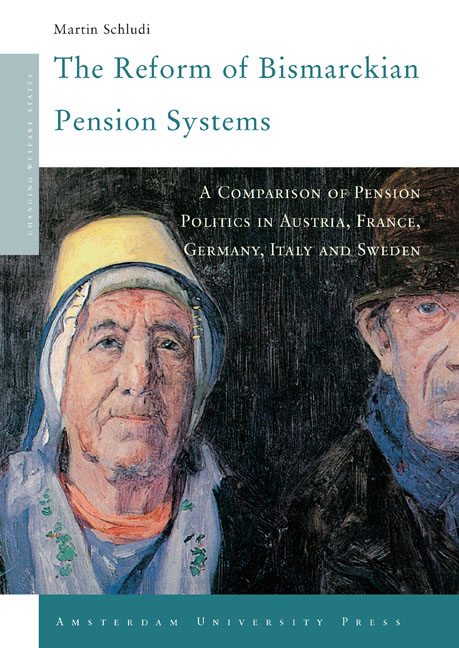 The Reform of Bismarckian Pension Systems
The Reform of Bismarckian Pension Systems Book contents
- Frontmatter
- Contents
- List of Tables/List of Figures
- Acknowledgements
- Introduction
- 1 The Need for Pension Reform:A Problem-Oriented Perspective
- 2 An Empirical Overview of Policy Change in Bismarckian Pension Regimes
- 3 The Politics of Pension Reform:An Actor-Centred Explanatory Framework
- 4 Sweden:Policy-Oriented Bargaining
- 5 Italy:Corporatist Concertation in the Shadow of EMU
- 6 Germany:From Consensus To Conflict
- 7 Austria:Reform Blockage by the Trade Unions
- 8 France:Adverse Prerequisites for a Pension Consensus
- 9 Conclusion
- Appendix I Summary Description of Retirement Systems (1986)
- Appendix II Chronology of National Pension Reforms
- Appendix III Glossary of Terms
- Notes
- Bibliography
- Index
4 - Sweden:Policy-Oriented Bargaining
Published online by Cambridge University Press: 24 January 2021
- Frontmatter
- Contents
- List of Tables/List of Figures
- Acknowledgements
- Introduction
- 1 The Need for Pension Reform:A Problem-Oriented Perspective
- 2 An Empirical Overview of Policy Change in Bismarckian Pension Regimes
- 3 The Politics of Pension Reform:An Actor-Centred Explanatory Framework
- 4 Sweden:Policy-Oriented Bargaining
- 5 Italy:Corporatist Concertation in the Shadow of EMU
- 6 Germany:From Consensus To Conflict
- 7 Austria:Reform Blockage by the Trade Unions
- 8 France:Adverse Prerequisites for a Pension Consensus
- 9 Conclusion
- Appendix I Summary Description of Retirement Systems (1986)
- Appendix II Chronology of National Pension Reforms
- Appendix III Glossary of Terms
- Notes
- Bibliography
- Index
Summary
Key features of the Swedish pension system in the late 1980s
Traditionally, the Swedish pension system differs from pension arrangements in the other countries studied, in so far as it provides for a basic pension covering all residents in Sweden over 16 years of age (including most foreigners). The National Pension System includes three schemes:
1 the basic pension (folkspension), which consists of a universal flat-rate pension, supplemented by various partially income-tested benefits (such as housing allowances);
2 the earnings-related supplementary pension (allmän tilläggspension, ATP);
3 the partial pension (delpension) consisting of a part-time early retirement pension.
Both the basic and the supplementary pension schemes provide for old age, invalidity, and survivors’ pensions.
All pension benefits are indexed in accordance with the so called “base amount” which is typically linked to the consumer price index. A single pensioner is entitled to a guaranteed “minimum pension” which amounts to 144% of the base amount (consisting of a basic pension which equals 96% of the base amount, and a pension supplement which equals 48% of the base amount).
The old age basic pension is normally payable from the age of 65. However, it may also be drawn from the age of 60, in which case the pension is reduced by 0.5% for every month under the age of 65. The basic pension scheme is financed by contributions from employers, central government, and local governments. The employer contributions are not earmarked for the pension but are in fact a payroll tax.
The general supplementary pension scheme (ATP) covers all economically active people over age 16. Self-employed people have the right to contract-out of the scheme. The supplementary pension is earnings-related, and is payable to anyone who has earned more than the “base amount”’ for at least three years. The amount of the supplementary pension scheme depends on the “average pensionable income” earned in previous years and on the number of years of gainful activity. For each year, a ratio is calculated by dividing the individual income (up to 7.5 times the base amount) by the general base amount for the respective year (“pension points”).
- Type
- Chapter
- Information
- The Reform of Bismarckian Pension SystemsA Comparison of Pension Politics in Austria, France, Germany, Italy and Sweden, pp. 89 - 108Publisher: Amsterdam University PressPrint publication year: 2005
- 1
- Cited by


